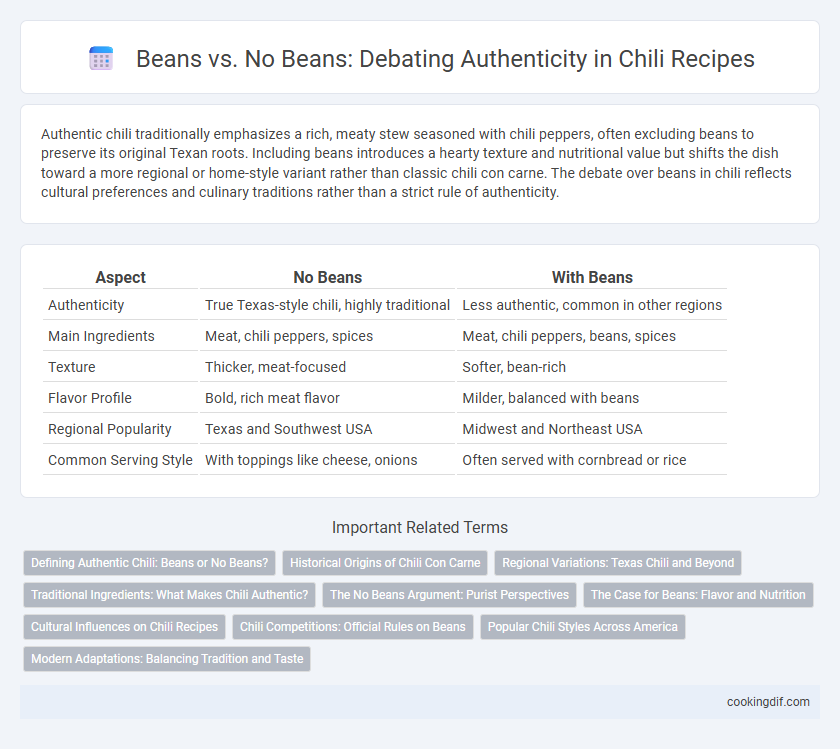Authentic chili traditionally emphasizes a rich, meaty stew seasoned with chili peppers, often excluding beans to preserve its original Texan roots. Including beans introduces a hearty texture and nutritional value but shifts the dish toward a more regional or home-style variant rather than classic chili con carne. The debate over beans in chili reflects cultural preferences and culinary traditions rather than a strict rule of authenticity.
Table of Comparison
| Aspect | No Beans | With Beans |
|---|---|---|
| Authenticity | True Texas-style chili, highly traditional | Less authentic, common in other regions |
| Main Ingredients | Meat, chili peppers, spices | Meat, chili peppers, beans, spices |
| Texture | Thicker, meat-focused | Softer, bean-rich |
| Flavor Profile | Bold, rich meat flavor | Milder, balanced with beans |
| Regional Popularity | Texas and Southwest USA | Midwest and Northeast USA |
| Common Serving Style | With toppings like cheese, onions | Often served with cornbread or rice |
Defining Authentic Chili: Beans or No Beans?
Authentic chili is often defined by regional traditions, with Texas-style chili, or "chili con carne," traditionally excluding beans to emphasize the rich flavor of slow-cooked beef and chili peppers. In contrast, many other American chili variations incorporate beans, enhancing texture and nutritional value, but this diverges from the strict Texan authenticity standards. Understanding these distinctions helps clarify that authentic chili, particularly in Texas, prioritizes a bean-free recipe focused on meat and spices.
Historical Origins of Chili Con Carne
Chili con carne historically originated in Texas, where traditional recipes emphasized meat, chili peppers, and spices, typically excluding beans to maintain authenticity rooted in 19th-century cowboy cuisine. Early chili cook-offs and Mexican-influenced Texan kitchens reinforced the no-beans style as a hallmark of genuine chili. Beans became more common in chili recipes later due to regional preferences and economic factors, but authentic chili con carne remains defined by its focus on meat and chili flavors without beans.
Regional Variations: Texas Chili and Beyond
Texas chili, known as "Texas Red," traditionally contains no beans, emphasizing beef, chili peppers, and spices to maintain authentic regional flavor profiles. In contrast, other regional variations, such as Cincinnati chili or Northern Mexican styles, incorporate beans as a staple ingredient, reflecting local culinary preferences and historical influences. This distinction underscores the diversity within chili recipes, highlighting how regional culture shapes ingredient choices.
Traditional Ingredients: What Makes Chili Authentic?
Traditional chili recipes emphasize the use of lean beef, chili peppers such as ancho or guajillo, and a blend of spices including cumin and oregano to create authentic flavors. The inclusion of beans varies by regional preference, with Texas-style chili traditionally excluding beans to highlight the meat and chili peppers, while other styles incorporate beans for texture and heartiness. Authentic chili relies on these core ingredients to achieve a rich, layered taste that reflects its cultural heritage.
The No Beans Argument: Purist Perspectives
The no beans argument in chili centers on preserving the dish's authentic Texas roots, where original recipes emphasize meat, chili peppers, and spices without the addition of beans. Purists assert that beans dilute the robust, smoky flavor profile and alter the chili's texture, straying from traditional cooking methods established in competitive Texas chili cook-offs. This perspective highlights the importance of maintaining chili's history as a meat-centric stew, distinguishing it from variations popularized outside the Southwest.
The Case for Beans: Flavor and Nutrition
Including beans in chili enhances its authenticity by adding a rich, hearty texture and a subtle earthiness that complements the spices and meat. Beans contribute essential nutrients such as protein, fiber, iron, and complex carbohydrates, boosting the dish's overall nutritional profile. The combination of beans with chili spices creates a balanced flavor harmony that reflects traditional cooking practices and satisfies diverse palates.
Cultural Influences on Chili Recipes
Chili recipes often spark debate over including beans, driven by regional and cultural influences where Texas-style chili typically excludes beans to highlight beef and spices, reflecting cowboy culinary traditions. In contrast, Midwestern and Southwestern variations incorporate beans, symbolizing agricultural heritage and accessibility of ingredients. This cultural divergence underscores how chili serves as a culinary expression of local identity and historical practices across different American communities.
Chili Competitions: Official Rules on Beans
Chili competitions like the prestigious Terlingua International Chili Championship enforce strict rules prohibiting beans to preserve traditional Texas-style chili authenticity. Official guidelines from the Chili Appreciation Society International (CASI) also mandate no beans in their contest recipes, emphasizing meat and chili peppers as the core ingredients. The inclusion of beans is widely regarded as a disqualification factor, underscoring the purist approach to chili cooking in competition settings.
Popular Chili Styles Across America
Popular chili styles across America often spark debate over authentic ingredients, with Texas chili famously excluding beans to emphasize a rich beef and chili pepper base. In contrast, Cincinnati chili incorporates beans and unique spices like cinnamon and cloves, reflecting regional tastes and traditions. These variations highlight how beans play a pivotal role in defining local chili authenticity and culinary identity.
Modern Adaptations: Balancing Tradition and Taste
Authentic chili recipes traditionally exclude beans, emphasizing slow-cooked meat and chili peppers to preserve Texan origins. Modern adaptations often incorporate beans to enhance texture and nutritional value, catering to diverse palates while retaining bold, smoky flavors. Balancing tradition and taste involves selecting quality meat, spices, and beans thoughtfully to achieve a harmonious chili experience.
No beans vs beans for authenticity Infographic

 cookingdif.com
cookingdif.com